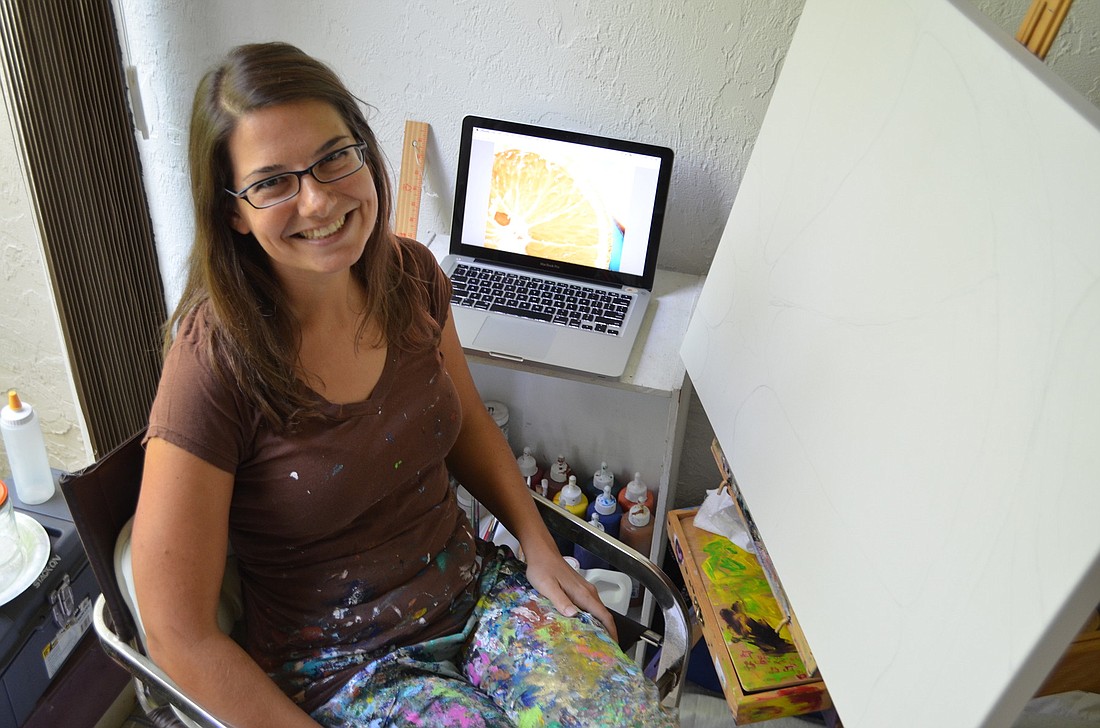- November 25, 2024
-
-
Loading

Loading

For six years Lisa Jacyszyn enjoyed celebrity status in Maui, Hawaii. Everyone knew the young visual artist, who goes by just Lesha, as in Cher or Madonna, for the mural-painted minivan she drove around the island.
The van she painted was her mobile advertisement for the four-hour en plein aire painting lessons she gave tourists. She painted the volcanic landscapes alongside her students — like Bob Ross. It was her dream fulfilled. That is, until the glamour of living on a tropical island eventually faded into the reality of the limited artistic opportunities of a small island; she needed more mental stimulation.
Although she taught others to paint landscapes, in her own work, the 38-year-old paints abstract realist work, or close-up portions of real subjects. So close, in fact, one might not realize what the subject is or think it’s surreal. State of the Arts Gallery features one of her pieces, and you can occasionally find her work on display at Art Center Sarasota.
 After leaving Maui in 2010, Lesha moved to San Francisco to pursue a graduate degree in Chinese medicine and create art on the side. She fell in love and moved to Sarasota to follow her heart and relationship. The relationship has since ended.
After leaving Maui in 2010, Lesha moved to San Francisco to pursue a graduate degree in Chinese medicine and create art on the side. She fell in love and moved to Sarasota to follow her heart and relationship. The relationship has since ended.
In December, she obtains her degree. Until then, she’s studying for six national exams — she barely has time to paint.
When she does have time, Lesha works in a small studio set up on her glassed-in lanai. Her condo at Pelican Cove in South Sarasota reminds her of Hawaii — it’s a similar oasis with the way the light hits the palms.
She’s slowly working on a new painting of a close-up portion of an orange slice. It’s a subject Lesha has been meaning to paint since college. Chilean poet Pablo Neruda’s “Ode to the Lemon” inspired the idea with the words, “Knives slice a small cathedral into a lemon.” It’s this image — the one that likens the pulp to stained-glass windows — that’s been sitting in the back of the visual artist’s mind.
Lesha started making abstract realist pieces in school at California College of Art. There, she frequented a Thai restaurant every Friday. One day she noticed the light streaming through the trees caused a lacy pattern on the tabletop. She thought, “I’m going to paint those patterns.”
Lesha took something ordinary, a shadow, and presented it so it looked extraordinary.
Lesha explains it like this: When she looks at a white wall, she doesn’t see white. She sees pinks, blues and purples falling across the wall, which is why she says she could make a roll of toilet paper look beautiful. It’s looking at the ordinary in a different way.
“To me it’s not the subject matter of a painting. (The canvas) is just a place to hang the colors of the lights and shadows,” she says.
Her focus moved from shadows to produce — she’s painted close-up portions of honeydew melon and moody-looking asparagus.
A more abstract piece she recently finished hangs on her lanai — it’s a microscopic image of silicon dioxide. It’s earthy-looking with green, brown, iridescent gold and teal and looks like rings of a tree tunneling into similar lined regions with gold steppingstones interspersed between.
The piece was inspired from a photography contest Nikon held for scientists. What she didn’t know when she was painting it is that silicon dioxide is quartz, the same white sand that makes up Siesta Key beach.
“This is why painting is cool,” she says. “I’m discovering new things all the time.”
Because of the detail in her work, this style of art takes her months to finish — and lots of materials. She used to teach art on the side to fund it, and it’s ultimately why she wanted to focus on Chinese medicine — as another means of survival.
“As it is now, I spend way more time, money and materials making the artwork than I ever get back,” she says. “It hasn’t been a profitable venture for me. It hasn’t happened — yet.”